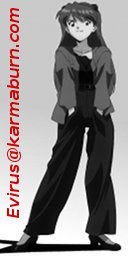|
|
- HOME
- Archive for Moshidora.
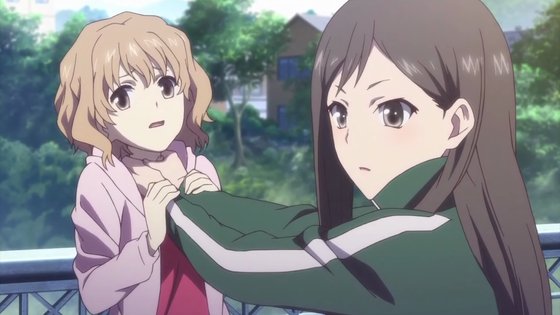
This is pretty half-assed choking, Minko.
The best show I'm watching this season is Hanasaku Iroha which basically takes Saten Ruiko from A Certain Scientific Railgun and forces her to work in an inn with some misfits. Theres the MAMIKORE gossipy Tomoe, the bitchy Minko, and the annoyingly meek Nako. There are also a number of adult characters, all with their own problems.
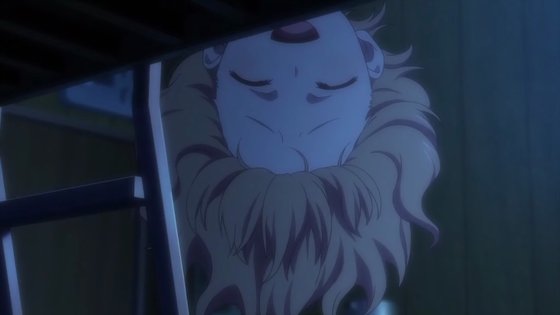
Even the turbo-genki voice is normal.
One thing I've come to enjoy about Ito Kanae is she does a fairly normal voice. Not that I don't enjoy high-fructose Yukana sweetness, for example, but that is a very artificial-sounding voice. Ito Kanae, like Sawashiro Miyuki, uses a more natural voice for her characters. Hanazawa Kana used to have one too back in her Zegapain days, but now she's all about the Hanakana Distortion Field brainwashing viewers.
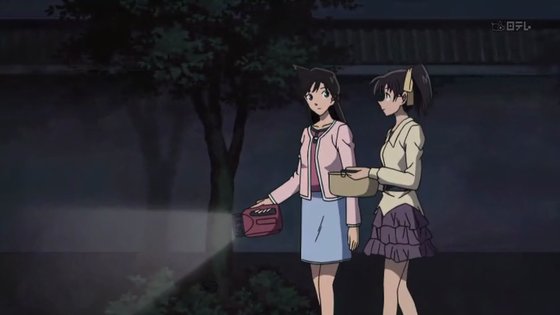
Ran really should get herself a Surefire flashlight one of these days.
Detective Conan continues this season from episode 610 with a Hattori arc. Where Hattori goes, Kazuha follows, bringing with her a Kansai-ben Miyamura Yuko (Soryu Asuka Langley) that I enjoy far too much. If you didn't know already, Rei and Asuka are both recurring characters in Detective Conan as Ai and Kazuha, respectively. Both need more screentime.
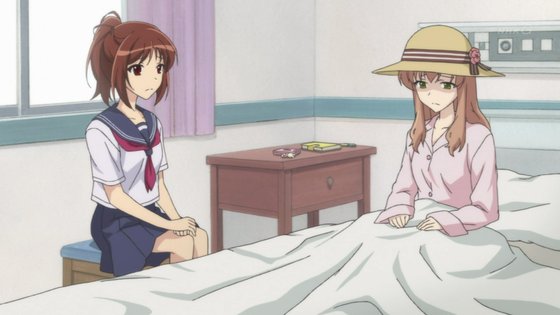
Nice hat.
Moshidora, also known as Drucker in the Dugout or as What If a Female Student Manager of a High School Baseball Team Reads Drucker's Management? (Full title: Moshi Kōkō Yakyū no Joshi Manager ga Drakkā no "Management" o Yondara) is frankly kinda low-budget, but it's refreshing in that it obviously caters towards adults, despite the high school setting.
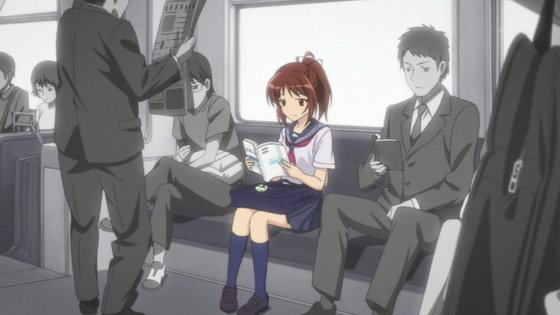
Minami must be reading an abridged edition. My copy is twice as thick.
As background material, I've actually started reading Peter Drucker's Management: Tasks, Responsibilities, Practices, but I'm only about halfway through the 800-page book. Because Moshidora airs daily and only has 10 episodes, I don't think I'm going to finish reading the book before I finish watching the anime. What I really want to do is read the novel that inspired the anime.
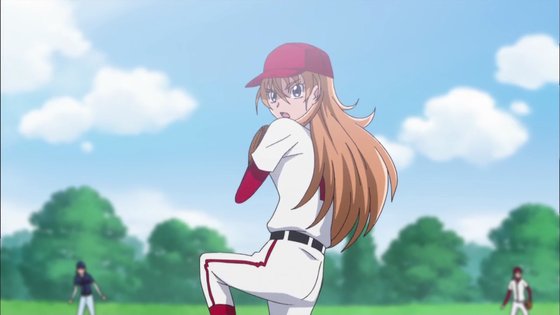
Hibiki works from the stretch, but I didn't see her check the runner first.
Suite Precure is in the process of bringing in more Cures, although the masked Cure Muse seems pretty obviously the sort-of-evil but out of work Siren to me. Personally, I have a feeling Cure Muse will be unmasked soon enough to henceforce be Cure Beat. Whether or not this means we'll see more of Cure Muse after that, I'm not sure, but maybe Suite Precure will handle it like Splash Star managed part-time Cures Cure Bright and Cure Windy.
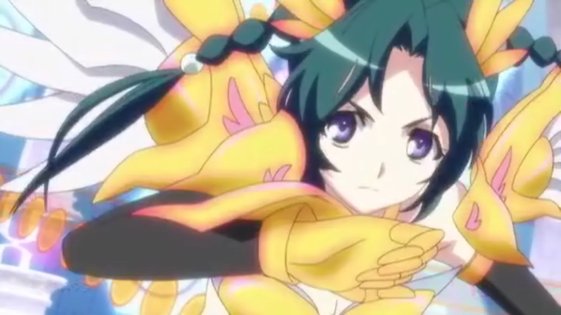
Suddenly, a magikal girl appears.
Seikon no Qwaser II continues to test the limits of what its viewers can expect and accept. Although off to a "slow" start, there is already a sub-plot about a previously smug bitch who has her soma extracted against her will, turning her quiet and meek while she burns with the subsequent shame and guilt she carries from enjoying the experience. Honestly, though, one thing Seikon no Qwaser has always done well is challenge expectations. There are allegories in the second season that address serious issues in irreverent ways. You don't have to care about those parts to necessarily enjoy Qwaser, but the fact that they're there is one of the reasons why Qwaser is not merely a smutty fan service show its dismissive detractors assume it is. Seikon no Qwaser does for fan service what Shin Seiki Evangelion did for giant robots, what ef ~a tale of memories~ did for moe blobs, and what Mahou Shoujo Madoka Magica did for magikal girls.

So who remembers when Wolverine was canonically five-foot three?
I dropped X-Men after two episodes, but not because it was bad. On the contrary, it was pretty good—way better than the '90s cartoon. Aside from the questionable casting of Hisakawa Aya as Storm, I basically have no issues with the show but I think I'll like it better in its inevitable dubbed incarnation. It's pretty obvious the X-Men anime will probably air dubbed on Cartoon Network or something. Aside from setting the first arc in Japan and, y'know, all the violence, it is very much a western-friendly cartoon. In fact, it's so western that I have to wonder if they set the first arc in Japan because the producers were afraid Japanese viewers wouldn't watch a western property without something they could directly relate to, just as the western producers for the upcoming Akira movie feel compelled to cast caucasian actors in Japanese roles because they're afraid western viewers won't watch something they can't directly relate to.
Posted in Detective Conan, Hanasaku Iroha, Moshidora, Seikon no Qwaser, Suite Precure♪, X-Men | Tags: baseball, Dropped Shows, Fan Service, Hanakana Distortion Field, Hanazawa Kana, Initial impressions, Mahou Shoujo, Mamikore, Miyuki Sawashiro | Permanent Link
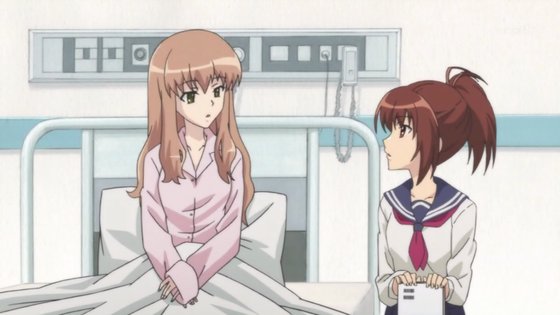
At least Yuki gets to wear pajamas instead of an open-backed hospital gown.
Moshidora received a lot of attention prior to the start of the spring 2011 anime season, probably because it is an anime adaptation of a popular book based on an unusual premise. So just exactly what would happen if a female manager of a high school baseball team read Peter Drucker's Management? Well, apparently she would be better at recruiting members for the team, innovating new tactics, and figuring out what to do with the weenie kid who's a complete liability under pressure because he's a choker.
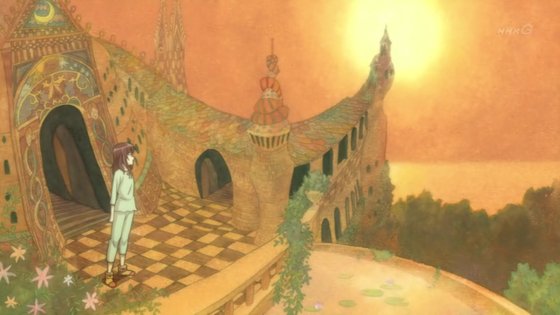
Minami gets to wear pajamas too, even in her hallucination about Innovation.
There are other aspects as well where Minami draws upon Management with almost religious fervor and applies them to her efforts at improving the team on Yuki's behalf—Yuki being Minami's friend and the real manager of the high school baseball team that she is too sickly to manage. (It's never explicitly stated what Yuki's illness actually is, but seeing as how there's no indication she was ever exposed to snow, she's probably not suffering from Key AIDS or Jun Maeda Malaria. My guess is she has leukemia or cancer, although she does maintain her radiant anime-heroine disposition and complexion, so whatever she has doesn't appear too outwardly taxing on her constitution. Also, the weenie kid on the team does not masturbate over her comatose body.
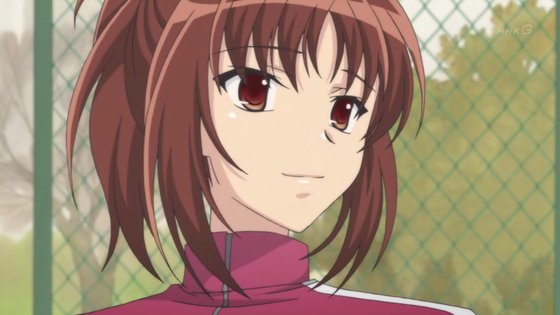
People complained about the animation, but Moshidora does have nice eyes.
After Moshidora aired (it ran 10 weekdays in a row, thus finishing well in advance of other spring 2011 shows), reactions were decidedly mixed. It seems basically anyone who did not have a genuine interest in baseball or business management abandoned Moshidora early. I'm curious what they were expecting, since most of these erstwhile enthusiasts never had any interest in baseball-themed anime in the past. What did they think would be different?

Relax, kid, we do this every day.
Let the record show that Moshidora is a good baseball anime, and a lot more realistic than something like Princess Nine which is good, but not at all authentic. I call Moshidora "realistic" despite the heavy emphasis on an "innovative" tactic the team adopts in response to a Peter Drucker-inspired lesson. The team's [SPOILERS] so-called No Bunt, No Ball strategy, while ridiculous on its face, is grounded in sound baseball principles.
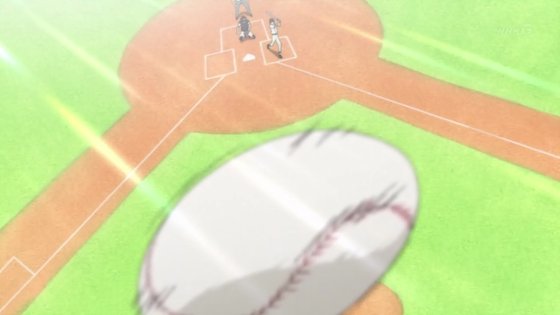
Now batting, number five, Ika Musume Jun Hoshide.
The "no bunt" half of the strategy dictates the team will not sacrifice bunt—ever. This is not necessarily an abandonment of "small ball" entirely, but is a departure from standard Japanese baseball doctrine (at least as depicted in anime): If you have a runner on first with less than two outs, sacrifice him over to second base so he'll be in scoring position for a base hit. Minami's team rejects this strategy entirely, but she may be in good company. Those of you who have read Moneyball or otherwise have a general understanding of sabermetrics will remember Oakland A's general manager Billy Beane despises sacrifice bunts and would never trade an out for a base.
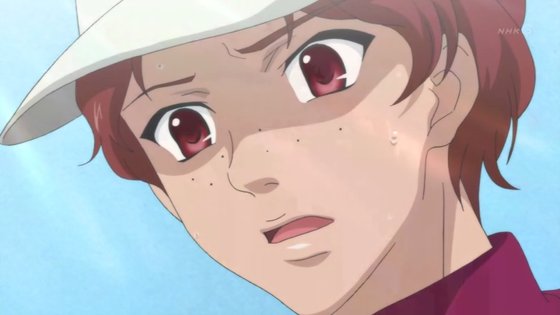
"Letting everyone else do all the work" is dangerous
with a defensive liability in the middle infield.
The "no ball" half of the strategy dictates the team's pitchers will only throw pitches in the strike zone. This part of the strategy is pretty dogmatic, and I have my doubts whether it could realistically be pulled off successfully. However, even this is grounded in sound baseball fundamentals—in this case, a very old fundamental that nobody seems to appreciate anymore: Work fast, throw strikes, and make everybody else do all the work. Those who believe a pitcher should rely on his fastball 75 percent of the time are likely more accepting of the "no ball" strategy, providing Minami's pitchers are able to change speeds, have enough movement on their fastballs, and have enough control to precisely place their pitches' locations, as opposed to basically heaving balls right over the plate (which is what Ryo from Princess Nine essentially does). Valuing control and location is something Big Windup got right, by the way, but I found that show unwatchable because of the ridiculous, relentless crying.
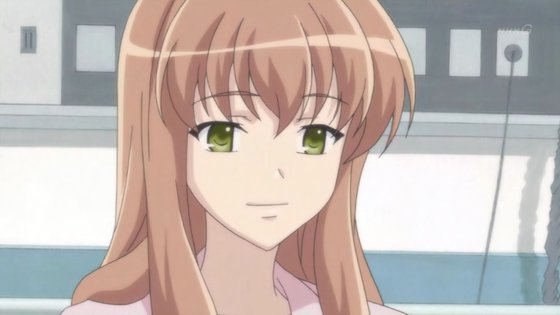
Don't you know it's summer, Yuki? Anime characters
are only allowed to be sick in the winter!
Speaking of which, is there crying in Moshidora? Well, yes, but nearly all of it takes place off the field. You may recall Tom Hanks' insistence in A League of Their Own, "There's no crying in baseball!" This is true, but I can let it go if it occurs outside the lines. In fact, crying is nearly inescapable in a good baseball anime, because—as I've come to realize recently—there is one consistent factor that is present in nearly all good baseball anime and manga. You'll find it in Cross Game, in Touch, in H2 (in basically anything Adachi Mitsuru writes, really), you'll find it A LOT in Major (basically the best baseball anime there is), and you'll even find it in Princess Nine:
Bad things happen to good people.
Baseball is a cruel sport. Despite one's best efforts, defeat and despair often seem unavoidable, and I'm not just talking about Cubs fans. There's a certain sense among players and die-hard fans that the game is rough—that life is unfair—and that stoical dedication to the game through its harshest moments somehow better prepares the baseball enthusiast for the rigors of a demanding world. Perhaps this is why Moshidora could not be an escapist moé blob sanctuary. Certainly it could not have dabbled in that type of otaku-pleasing pandering in its early episodes—even to "grab" casual viewers—and still have had the integrity to execute its final episodes as well as it did. It wouldn't have been proper in a short 10-episode series.
Posted in Moshidora | Tags: Bad Things Happen to Good People, baseball, books, Hanakana Distortion Field, Jun Maeda, Spoilers, Spring 2011, Superlovely Character Designs | Permanent Link

Spoilers: Kaoru won't win this year.
Halfway through 2011, I propose the following tentative nominations for Girl of the Year. I'm providing this update so characters from shows that ended during 2011's first half don't get overlooked by the myopia that seems to set in each December.
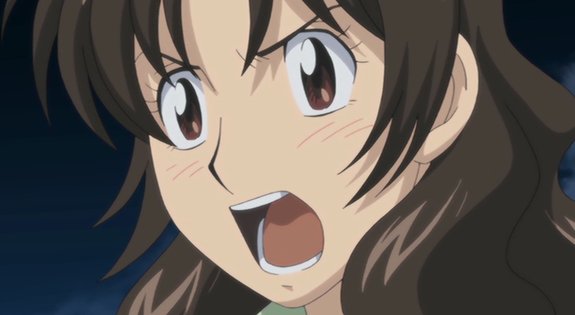
Go on, Momoko, bitch those jackasses out.
As a former winner (2009), Shimizu Kaoru from Major would normally get an automatic nomination for returning in the OVA epilogue, but she's inelligible because it came out December 2010. Unfortunately, this means I also can't nominate Momoko from the same OVA. Momoko first appeared in Major season one as Goro's kindergarten teacher and has been a regular part of the series ever since. She definitely deserves recognition for her contribution to the best baseball anime of all time. (Neither could have won in 2010, by the way, as Aoba from Cross Game had that title locked up nearly from day one.)
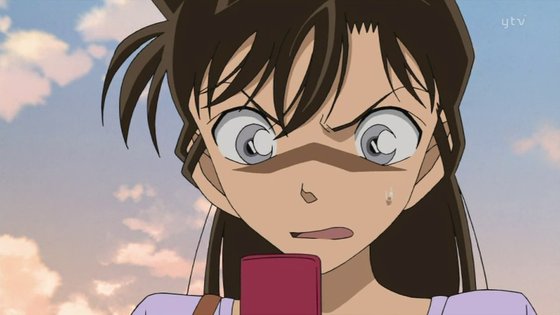
This usually means someone's about to get fucked.
Mouri Ran gets a nomination because Detective Conan is as good as it ever was. As long as the series continues to air (or the franchise continues to churn out OVAs and movies), Ran will get a nomination by virtue of being a long-suffering sweet kid and one of anime's All Time Babes. Actually, I say "as good as it ever was," but this year it might be better than ever. It's still really good at least.

It helps that Minami has awesome hair.
Minami from Moshidora adds to the growing list of nominations from baseball anime. Minami's initial contribution to Moshidora is a gimmick, but it's an interesting one, and both Minami and Moshidora continue to grow over the course of the season.
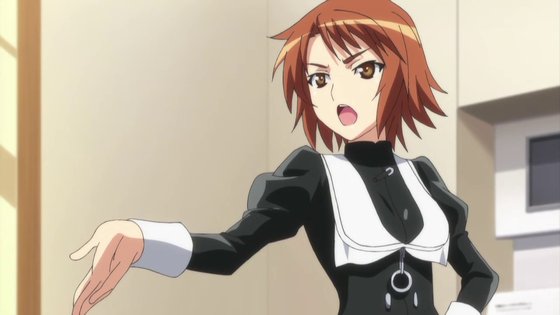
Hana and Katja should get their own show when Qwaser ends.
Hana from Seikon no Qwaser II carried the show during its early uncertain episodes, and I'm not just saying that because part of it took place inside her ass. Hey, that's two characters nominated now for Hikasa Youko (best known for her role as Mio in K-On!).
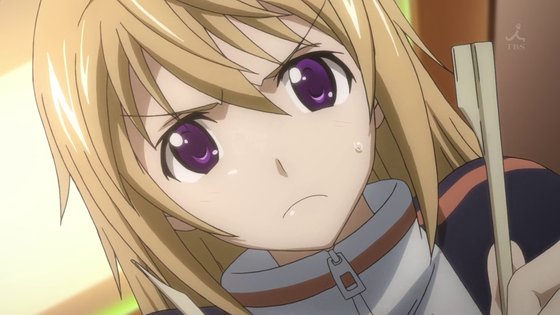
Charles is from fork-lovin' France.
It's a pity Houki didn't have much to offer in IS: Infinite Stratos, otherwise Hikasa Youko might have managed a hat trick. At least Infinite Stratos doesn't walk away emptyhanded, though. Its very popular Charles easily gets a nomination even though she unconvincingly tried to disguise herself as a boy initially.
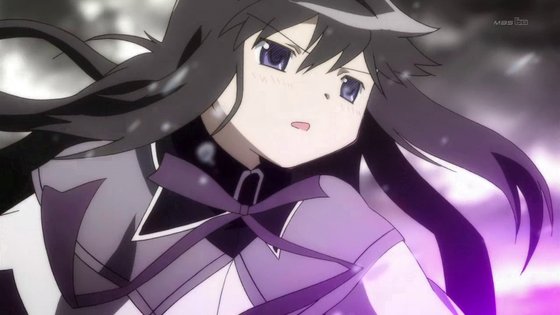
Also for being a magikal girl King of the Battle.
Homura from Mahou Shoujo Madoka Magica gets a nomination for her indefatigable [SPOILERS. DECLASSIFY IN 30 YEARS].
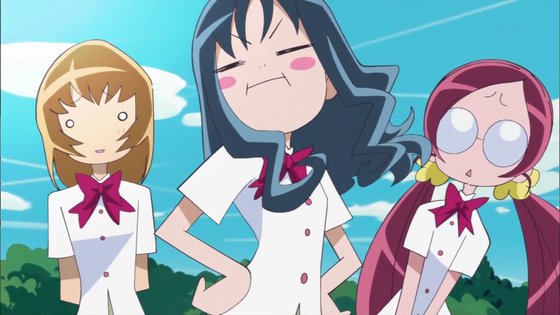
Erika is kinda smug sometimes though.
Erika from Heartcatch Precure! manages a nomination for 2011 despite not receiving one in 2010. Although she's the first Pretty Cure to be nominated, Erika arguably only gets the nod because of the relatively weak field so far in 2011 and for being the most generally liked character in Heartcatch Precure!
So there you have it. Note, however, these are only preliminary nominations for 2011, and the field could change dramatically depending on how the rest of the year plays out. No doubt, this field is also limited by the relatively few shows I've followed this year. But before anybody says anything, nobody from Ano Hana gets in. Not even close.
Posted in BEST GIRL, Detective Conan, Heartcatch Precure!, IS Infinite Stratos, Mahou Shoujo Madoka Magica, Major, Moshidora, Seikon no Qwaser | Tags: All-Time Babes, baseball, Fan Service, Girl of the Year, Girl of the Year 2011, Hair, Mahou Shoujo, Movies and OVAs | Permanent Link
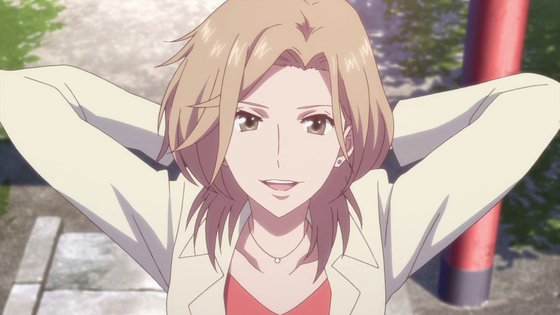
You're still a lousy mom, Satsuki.
The best show I watched spring 2011 was Hanasaku Iroha. Consistently engaging, with characters I cared about and the high levels of animation quality I've come to expect from P.A. Works, I always looked forward to the next episode. I'm glad it's continuing for another cour in summer 2011. However, I initially thought Ohana would take an early lead in the race for Girl of the Year, but surprisingly she is thus far not in the running. In fact, it is scene-stealing Minko who is poised to garner the year-end nomination, provided she gets past Tomoe first, the current front runner for Hanasaku Iroha's Best Girl.
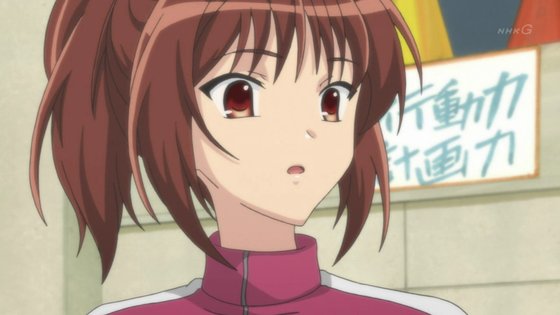
Surprise! Moshidora gets better with each episode!
It almost doesn't feel as if Moshi Kōkō Yakyū no Joshi Manager ga Drakkā no “Management” o Yondara was part of spring 2011 because it ended so early. (Its 10 episodes aired during consecutive weeknights for two weeks at the start of spring 2011.) Accused early on of having low production values and an unengaging storyline, Moshidora's detractors mostly abandoned the series by the second episode. It's too bad, really, because Moshidora improved with nearly every episode, culminating in a satisfying finale that underscores the difference between anime based on juvenile or young adult "light" novels and anime based on books aimed at adults.
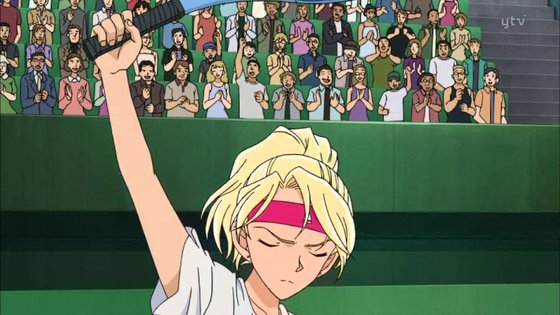
Minerva Glass is here to eat bangers & mash and kick ass.
And she's all out of bangers & mash.
Detective Conan is as good as it ever was. In fact, it was better than usual this season. The long London arc in particular was a nice change of scenery. Minerva Glass was also a nice addition to the cast, although I suspect she will not be a recurring character. Many of her scenes reminded me of the old David Foster Wallace article "The String Theory." Be sure to read all the footnotes.
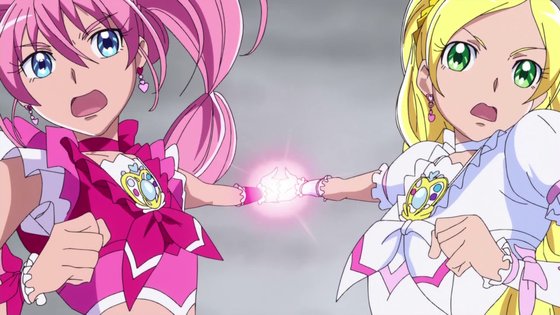
Suite Pretty Cure is here to eat cake and kick ass.
And they're all out of...wait, there's some more cake in the house.
Suite Precure♪ suffered from weak-protagonist syndrome, but Hibiki and Kanade have mostly found their footing by now. I'm glad the show is drawing out its Cure Muse mystery, throwing out a number of red herrings regarding her identity and her role. This makes Toei only marginally better at protecting its properties from spoilers, though. Cure Beat's identity and details were widely known months in advance.
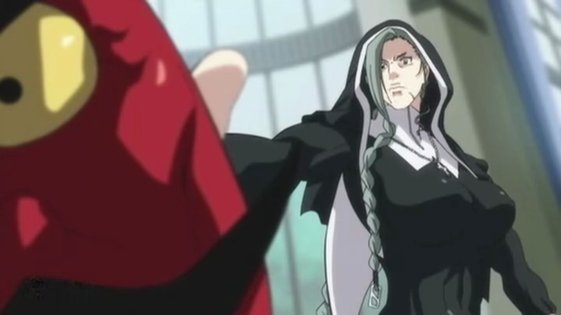
Big Mom is big.
The second season of Seikon no Qwaser is not as good as the first. The difficulty comes in trying to live up to the predecessor's reputation or trying to surpass the first season's achievements. Along those lines, it was really only successful with episode 10. Probably developing its characters more would have served Qwaser II better.
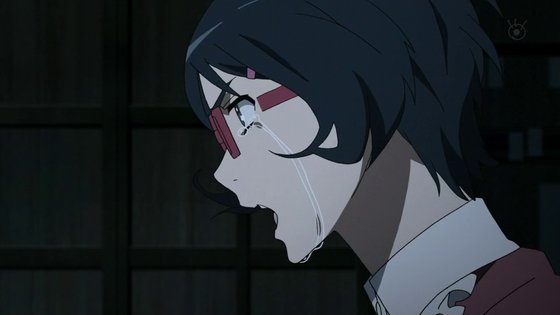
Ahh! Ghost glasses!
I did not enjoy Ano Hi Mita Hana no Namae o Boku-tachi wa Mada Shiranai nearly as much as most people seemed to have. Ano Hana had a huge following of emotionally invested fans. I found every character irritating, trite, juvenile, and overly melodramatic. It didn't help that Cross Game recently dealt with a similar theme in a far superior manner. (Haruka Tomatosauce, Anaru from Ano Hana, plays Aoba in Cross Game. You should give Cross Game a try if you haven't seen it already.) It also kinda bugged me how everyone's thick emo glasses developed side-view transparency so that they wouldn't obscure the characters' eyes in profile, but now I'm nitpicking.
I dropped X-Men even though I thought it was pretty good. I'm just waiting for the English dub, since the show seemed so western. I heard there's stunt casting for the English voices, though. Something about the cast of Heroes. I'm not really sure.
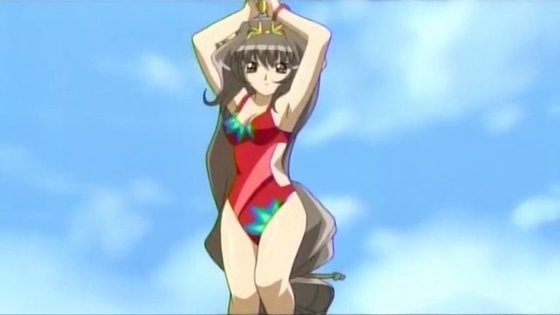
Cosprayers Line.
I sort of wanted to watch three episodes of Pretty Rhythm Aurora Dream to see what in Hell King in Prussia was talking about about, but the show is too awful. I could suffer through more if it had some redeeming qualities, but man, watching that crap is painful. Yes, Pretty Rhythm Aurora Dream is worse than Cosprayers. At least there weren't any live-action segments in the second episode.
Posted in Ano Hi Mita Hana no Namae o Bokutachi wa Mada Shiranai, BEST GIRL, Detective Conan, Hanasaku Iroha, Moshidora, Pretty Rhythm Aurora Dream, RECOMMENDATIONS, Season Summary, Seikon no Qwaser, Suite Precure♪, WORSE THAN COSPRAYERS, X-Men | Tags: baseball, Dropped Shows, Fan Service, footnotes, Legs that go up to her neck, Mahou Shoujo, Season Conclusion, Spring 2011 | Permanent Link

Consolation prize.
Choosing the Girl of the Year for 2011 shows how views held at the mid-year mark can change months later even without much additional information. As you may recall, the initial front runner was Homura from Mahou Shoujo Madoka Magica, with Charles and Ran looking to place and to show. However, after another six months of deliberation, I think I may need to reconsider my choices.
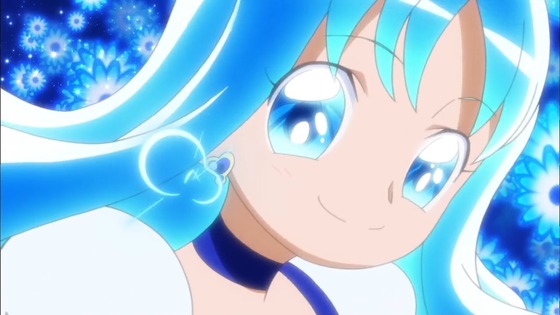
Cure Marine is proof All Stars hazing works.
Going through my initial recommendations, Erika from Heartcatch Precure! does even better in light of how uninspiring the entire cast of Suite Precure♪ has been. Nearly all the Suite Precure♪ characters are all right. (Not Cure Muse. Cure Muse is straight-up terrible.) However, they are so underdeveloped. Even Buki and Miki from Fresh Pretty Cure have more personality than the Suite cast. And the Suite Cures all seem to make such terrible choices. Not that Erika was a sound voice of reason in Heartcatch, but Erika at least had a lot more verve than any of the current crop of Cures, so the things she did were almost always entertaining, even when they were ill conceived. Nevertheless, while Erika certainly makes the Suite cast look bad, it's not enough to win her Girl of the Year.
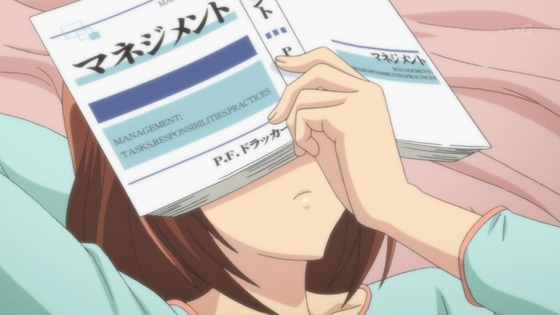
My copy of Management is twice as thick.
As far as I can tell, Moshidora was wildly unpopular, but I thought it was pretty good. It's rare for a show to get better with every episode. I might be looking at this through baseball goggles (they're like instrument goggles, okay), but Minami from Moshidora easily deserves a Girl of the Year nomination. She doesn't have enough to win, but you can't expect someone to go to the Koshien and win Girl of the Year in the same year, can you? Nobody is that good. Oh, wait. Aoba from Cross Game did that just last year.
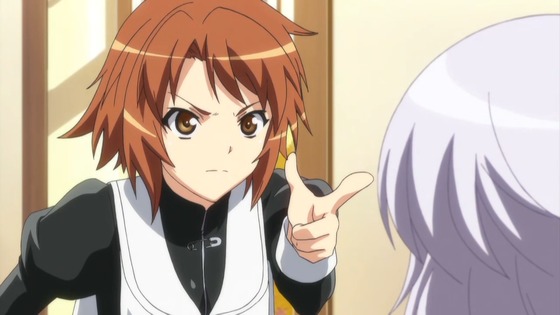
Go on, Hana, curse the bitch out.
Hana carried the second season of Seikon no Qwaser through its early lacklustre episodes. Carried it in her ass. [P.S. SPOILERS.]
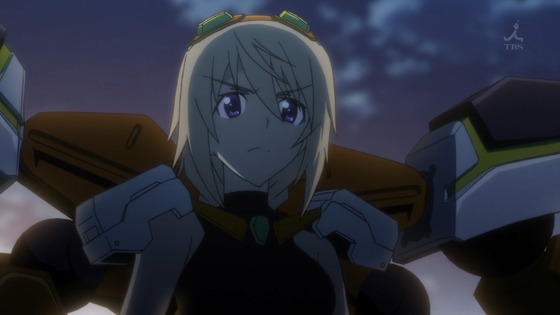
Who are you going to believe, sweetheart? Me or your lyin' eyes?
Early in the year, it really seemed as if Charles from IS: Infinite Stratos had a legitimate change of winning. I suppose she did, but as I mentioned with regard to the OVA, the end of the series basically threw away everything that made Charles great. Instead, she just became another blushing simpleton in Ichika's harem. How things would have been different if she had been absent from the series' final scene! It could have played out otherwise unchanged, but for a brief cut away to Charles sitting quietly in her room, reading one of those books Ichika keeps around for show, maybe looking up curiously to ask, "What is that racket outside?" Alas, somewhere along the way the writers forgot what made her great. Charles doesn't win.
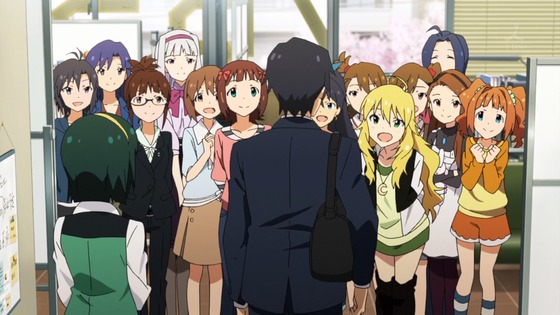
Say, do we have any cake?
Based on how much I like The Idolm@ster TV, you might expect one of the 765 girls to win this year. The truth is, I'm not even sure who to nominate. Idolm@ster relies very much on its ensemble cast, and as much as I like most of the girls individually, I like them collectively more. So, the first ever group nomination goes out to Chihaya, Miki, Takane, Ritsuko, Haruka, Mami, Makoto, Iori, Hibiki, Ami, Azusa, Yayoi, Kotori, and Yukiho. They don't win, though. I'm not ready.
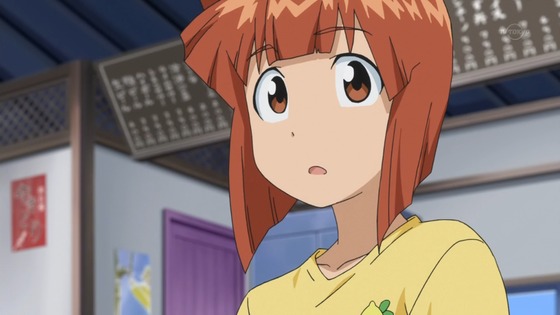
It's a good year for horn hair.
Even though I'm still not entirely sure squids are eligible to win Girl of the Year, Ika Musume managed a nomination last year for being pretty much non-stop awesome. Unfortunately, the second season of Ika Musume spent a lot of time, well, treading water for the most part. In fact, I'm inclined to think the Best Girl in Ika Musume II isn't even the title character. Eiko has been a solid straight man throughout the series, perhaps because she doesn't rely on having some broadly painted quirk to define her. Of course, now that I think about it, Eiko's role doesn't even necessarily require a female character. Eiko could have been a teenage boy, and the only real change to the show would be perhaps not having Ika Musume sleep in the same bedroom. Nobody from Shinryaku!? Ika Musume gets a nomination, by the way. Not this year.
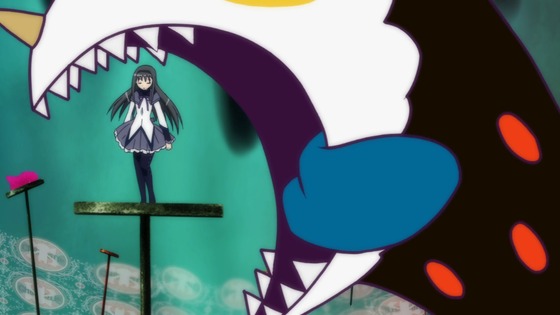
Hey, there's more cake over at Suite Precure♪.
If you've been paying attention, you've already figured out the heavily armed witch killer Homura does not win this year. There were two obstacles in her way. First, Homura is handicapped by my general dislike of SHAFT and Shinbo and the sophomoric fans they attract. Second, Homura's defining characteristic—or at least the one working most in her favor—is her indefatigable dedication. It's admirable, but even Homura can learn a thing or two about tireless devotion from this year's winner: Ran.
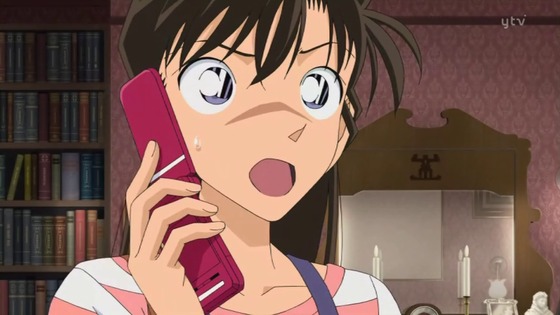
Believe it, baby.
Long-suffering Mouri Ran is 2011's Girl of the Year. Ran has always been good enough to win every year, but a relatively weak field for 2011 coupled with an especially good year for Ran puts her over the top. Ran's peculiar similarities to Homura also helped seal the win. I say "long-suffering," but not very much actual in-show time has passed for Ran. Like Homura, Ran is essentially trapped in time, doomed to absorb hundreds of failures, surrounded by death, and never achieving the peace she seeks with the one she loves.
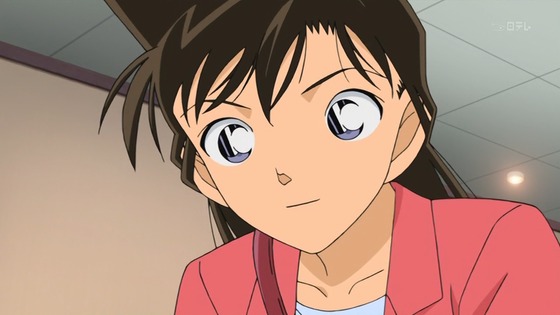
Lifetime Achievement Award.
For over six hundred episodes and more than a dozen movies, poor Ran hasn't been able to catch a break, but thankfully, there was some progress in 2011. This year, Detective Conan was at least kind enough to offer her the Valentine's Day arc, the White Day arc, and very compelling London arc, all of which which combine satisfyingly in ways unexpected for a show as generally static as Detective Conan. Congratulations, Ran, 2011's Girl of the Year.
Posted in BEST GIRL, Heartcatch Precure!, iDOLM@STER, THE, IS Infinite Stratos, Mahou Shoujo Madoka Magica, Moshidora, Pretty Cure All Stars DX, Seikon no Qwaser, Shinryaku! Ika Musume, Suite Precure♪ | Tags: All-Time Babes, Autumn 2011, baseball, Detectives, Fan Service, Girl of the Year, Girl of the Year 2011, Girls With Guns, Hair, Harem Comedy, Instrument Goggles, Love Confessions, Mahou Shoujo, Sequels, SHAFT, SHAFT X SHINBO, Spoilers, Spring 2011, Summer 2011, Winter 2011 | Permanent Link
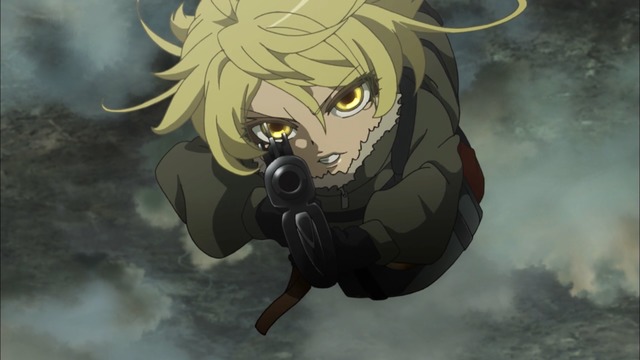
Shouldn't she be wearing some goggles?
On its face, Youjo Senki (The Saga of Tanya the Evil) should be absolute light-novel garbage. According to those who have investigated the source material, the original light novel really is the sonorous trash you get in these sorts of reincarnation stories. The actual execution, though, is surprisingly deft. And while its appeal is somewhat niche, it does appeal to me, and it safely stays out of the uncanny valley of military anime. Notably, the air battles are quite good, and are a great deal more satisfying than what we got from Brave Witches or Strike Witches. It's easy to accept this is the way witches and warlocks might fight, particularly when one is clearly stronger than the others.
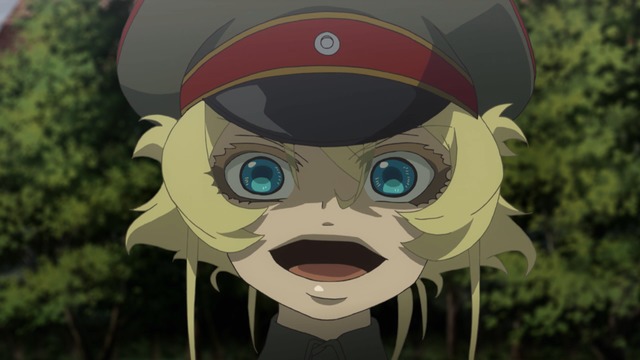
Duckface.
However, there's still the issue of Tanya's backstory. Through two episodes at least, there's not really a compelling reason why she needs to be a reincarnated Japanese salaryman. I can at least appreciate that the flashback to her previous death was executed in a clever way. Then again, at this point, just not getting hit by a truck sort of qualifies as being somewhat clever by default. Possibly the story will actually include Tanya's past life's corporate experience as a way to improve her chances on the battlefield, but I'm not expecting any sort of Moshidora epiphanies. Really, trying to make a Moshidora connection to Youjo Senki is tenuous at best, and I confess I only bring it up here and in the title of this post so I can pretend to casually mention I read an 800-page Peter Drucker book from the '70s in 2011 for a baseball anime which hardly anyone watched. Good times.
Posted in Brave Witches, Moshidora, Strike Witches, Youjo Senki | Tags: Air Power, Girls With Guns, Light Novels, OP ED, Season Introduction, war, Winter 2017 | Permanent Link
|
|










